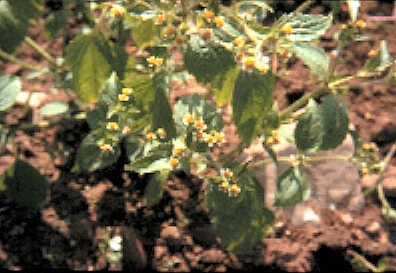Growers who want to prevent seed production of Galinsoga should be controlling it when it begins to bloom in early-tilled fields.
Galinsoga is an annual weed that is a perennial problem for many vegetable growers, particularly in the Connecticut River Valley. Galinsoga can be recognized by its small, white flowers with golden yellow centers and fuzzy, light green leaves. Galinsoga is small, with entire plants generally being no more than 10 inches tall. Galinsoga is highly competitive and quickly spreads and becomes dominant in a field. The following tips may be of use if you have problems with Galinsoga.
1. If you don’t have it, don’t get it. If you needed the description to know what galinsoga looks like, then you probably don’t have it. Galinsoga is invading farms on which it has not been previously seen. It may be a good idea to scout fields, especially edges, starting in June. If you see galinsoga, consider using hand hoeing or other measures to eliminate it. Time spent hoeing now may save you countless frustration and expense in the future.
2. Use crop rotation to your advantage. Galinsoga is a particular problem in cole crops, peppers and squashes. Try to rotate out of those crops in galinsoga-infested fields. Corn and tomatoes are crops in which herbicides are available to give good weed control.
3. Avoid spreading galinsoga. If you have galinsoga, chances are some fields are worse than others. If you can clean equipment after working in those fields, you will reduce spread. Even a partial cleaning job, banging off the biggest clods, is better than nothing.
4. Consider the eradication approach. Some growers have found that galinsoga has become so bad in some fields that the fields are close to unusable. Several have tried using a summer cover crop of sorghum x Sudan grass to suppress galinsoga. If a summer cover crop is thick enough to prevent galinsoga seed production, it should help to reduce galinsoga problems. Galinsoga seeds are relatively short-lived in the soil, so if galinsoga plants are prevented from going to seed for several years, this nasty weed should be greatly reduced in numbers, if not eliminated. Another option besides summer covers is a “dirt fallow” – repeated discing of the field so that it stays weed free all season. Extra expenses from cover cropping, taking land out of production and hand weed control may pay off in particularly bad fields.

Reviewed and updated: T. Jude Boucher, UConn IPM, 2012
The information in this document is for educational purposes only. The recommendations contained are based on the best available knowledge at the time of publication. Any reference to commercial products, trade or brand names is for information only, and no endorsement or approval is intended. The Cooperative Extension System does not guarantee or warrant the standard of any product referenced or imply approval of the product to the exclusion of others which also may be available. The University of Connecticut, Cooperative Extension System, College of Agriculture and Natural Resources is an equal opportunity program provider and employer.